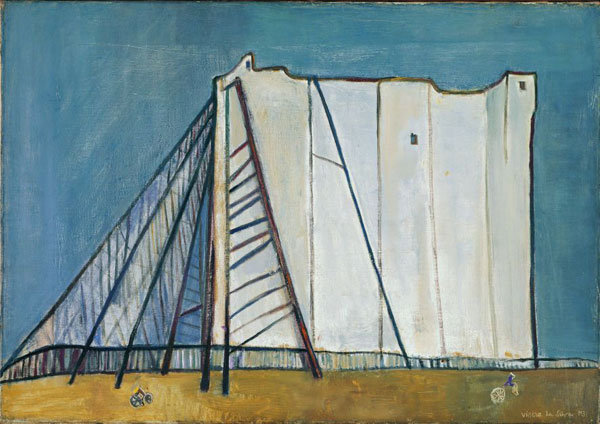De Torres Garcia a Vieira da Silva
dal 4/3/2009 al 2/5/2009
Segnalato da
IVAM Institut Valencia' d'Art Modern
4/3/2009
De Torres Garcia a Vieira da Silva
IVAM Instituto Valenciano de Arte Moderno, Valencia
La intuicion y la estructura, 1929-1949

“Torres-García – A tower in white, black, grey, cobalt blue, red earth, stairs and clocks, a world at once severe and joyous; a world I entered in 1929 and where I am still living.”
Maria Helena Vieira da Silva, in Torres-García. Construction et Symboles, Musée D’Art Moderne de la Ville de Paris, Paris, 1975
(exhibition catalogue).
The exhibition, Intuition and Structure, from Torres-García to Vieira da Silva, 1929 – 1949, opens with Maria Helena Vieira da Silva’s discovery of Joaquín Torres-García’s work in 1929, through to 1949, the year of Torres-García’s death in Montevideo. Over this period, the artists learned from each other and asserted their very particular structure, all the more particular for belonging to a sort of no-man’s land between abstract and figurative composition. The common chord between the two oeuvres is a question of sensibility and intuition, was the need for the support of a pictorial structure in order to find a synthesis between constructivism and intuition, primitivism and modernism.
What they searched for in essence, and never disavowed, was a universal form of art charged with humanism. However, it would be misleading to try to point out what the young Vieira da Silva may have contributed to the artist she regarded as her master. What she saw in Torres-García’s work was the possibility of a pictorial order and unity combined with the most intuitive, the most detached and the freest sensibility.
Vieira da Silva and Torres-García never met, but they exchanged ideas through their work, an encounter via artistic intermediaries when, in 1942, the painter and poet Arden Quin travelled to Rio de Janeiro and he visited Vieira da Silva’s studio – she had been living in Brazil with her husband, Arpad Szenes, since the outbreak of war in Europe. Arden Quin took photographs some of Vieira da Silva’s work and gave them to Torres-García on arriving in Montevideo. Torres-García replied with a flattering article in the journal Alfar, writing about the painting “Le désastre” ou “La guerre” (1942).
Whilst the exhibition, Intuition and Structure, from Torres-García to Vieira da Silva, 1929 – 1949, is not built around chronological and historical facts alone, it nonetheless traces a precise and perceptible path through these twenty years of rebounding influences between the work of the two artists. Our hope is to enable the visitor to see the achievements of Torres-García through the eyes of Vieira da Silva, and vice versa, and also to read in the painting of Vieira da Silva the complexity of these influences, and their transformation into an oeuvre at once highly secretive, and highly determined. Torres-García, in his relentless quest for a universal artistic language, draws on the sources of European and North American movements, as well as on those of primitivism.
In 1929, Torres-García conceived the movement and the journal Cercle et Carré, and founded them with Michel Seuphor and Piet Mondrian, Sophie Täuber-Arp, Jean Arp, Wassily Kandinsky, Jean Gorin and Georges Vantongerloo. This journal gave Torres-García a platform for his theories on the visual arts.
He now woke up to the possibility of a universal language with these schematic and stylised representations. On his return to Montevideo in 1934, and through to his death in 1949, his teaching at his workshop-school, the Taller Torres-García (TTG), and his lectures gave shape to a young generation of artists.
Torres-García’s wealth of theoretical argument adds nothing to Vieira da Silva’s work, whose beginnings and development are comprehensible only in the silence of contemplation. The years from 1929 to 1949 were spent in an persistent quest to unlock space, as she sought a happy medium between surface and depth. The grid lines, serving as the support for the chromatic vibrations she discovered from canvas to canvas, emerged as her solution for challenging the set nature of the flat plane continuum by means of the constantly changing points of view. Space in her paintings is at once constructed and deconstructed, in a perspectival conjuring trick where shimmering forms evoke the labyrinth of the spirit.
The years she spent in Brazil encouraged her to be bold, during the painful and unsettling years of world war led, she produced her agonising works Le désastre ou La guerre (1942), Le calvaire (1942), L’incendie II (1944), and also La partie d’echecs (1943). These paintings prefigure her post-war masterpieces, caught between spatial continuity and discontinuity.
IVAM Institut Valencià d’Art Modern
Guillem de Castro, 118 - 46003 Valencia
Opening Hours:
Tuesday to Sunday: 10 am to 8 pm
Monday: closed



